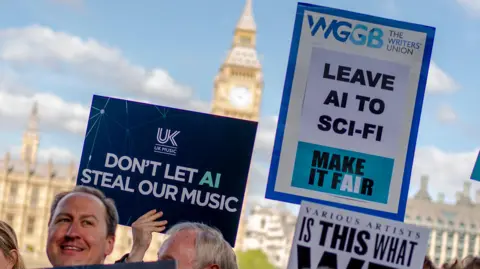The ongoing debate surrounding artificial intelligence (AI) and copyright law has reached a critical juncture, as the tensions between government policies and the interests of the creative industry show no signs of resolution. Central to this contentious issue are questions of fairness, copyright ownership, and the future of creative professions. As this topic takes center stage once more in the House of Lords, it continues to evoke strong sentiments and significant pushback from a community of artists and creators.
The heart of the dispute lies in the conflict between the evolving needs of the tech sector and the established rights of creative individuals. The primary focus of contention is the proposed Data (Use and Access) Bill, which seeks to streamline the way AI developers can access copyrighted material. Under the current stipulations of the bill, AI developers are granted broad access to content unless individual creators opt out—a position that has drawn stern criticism. Nearly three hundred members of the House of Lords advocate for increased transparency and the necessity for AI firms to disclose which copyrighted works they utilize in training their algorithms, arguing that this is crucial for protecting the interests of creative contributors.
Prominent figures from the creative field, including Baroness Beeban Kidron—a respected film director known for works like “Bridget Jones: The Edge of Reason”—have been vocal opponents of the bill. Kidron has warned that if the government does not provide adequate protections, it will expose the UK’s creative workforce to “state-sanctioned theft.” She emphasizes the significance of the creative sector, which reportedly contributes £124 billion to the UK economy. In light of this, she proposed amendments to ensure that the impact of AI on the creative industries is evaluated thoroughly after the bill’s enactment.
Adding to the complexity of the debate is Sir Nick Clegg, a former president of global affairs at Meta, who has supported the bill, suggesting that requiring permission from every individual copyright holder would ultimately stifle the growth of the AI industry in the UK. This division among policymakers and industry leaders underscores the contentious nature of the proposed legislation. Meanwhile, the Technology Secretary, Peter Kyle, has shifted his stance on copyright law, indicating that the existing framework may not be adequate for contemporary needs.
The wider implications of this legislation extend beyond the immediate concerns of copyright owners. Alongside artists and writers, there are fears that if the bill remains in its current form, it may push AI innovators to seek opportunities in more accommodating jurisdictions, potentially resulting in a loss of investment and job creation in the UK.
At the core of the deterrent is the evolution of AI technologies. The rapid advancement of AI has led to widespread usage of algorithms trained on vast amounts of content harvested from the internet, often without consent. This phenomenon has raised eyebrows and sparked a backlash among various stakeholders in the creative realm. Notable artists like Sir Elton John, Sir Paul McCartney, and Dua Lipa have joined the chorus, arguing that the unregulated use of their work without consent is tantamount to theft and diminishes their livelihood as AI-generated content becomes increasingly prevalent.
Furthermore, the roots of the controversy can be traced back to how AI developers have historically approached content acquisition. Initially, many believed that by sourcing material from the public domain, they were not infringing on copyright laws. However, the implications of such actions have become more contentious as AI technologies continue to evolve and replicate artistic outputs with alarming efficiency.
Moving forward, the ongoing dialogue around the Data (Use and Access) Bill represents a pivotal chapter in deciphering the intersection of technology, creativity, and legal frameworks. While there are numerous perspectives on how best to proceed, it is clear that a balance must be found to protect the rights of artists and creatives while fostering innovation within the tech industry. As discussions evolve, the challenge remains to navigate this uncharted territory without sacrificing the principles core to both artistic expression and technological advancement.



